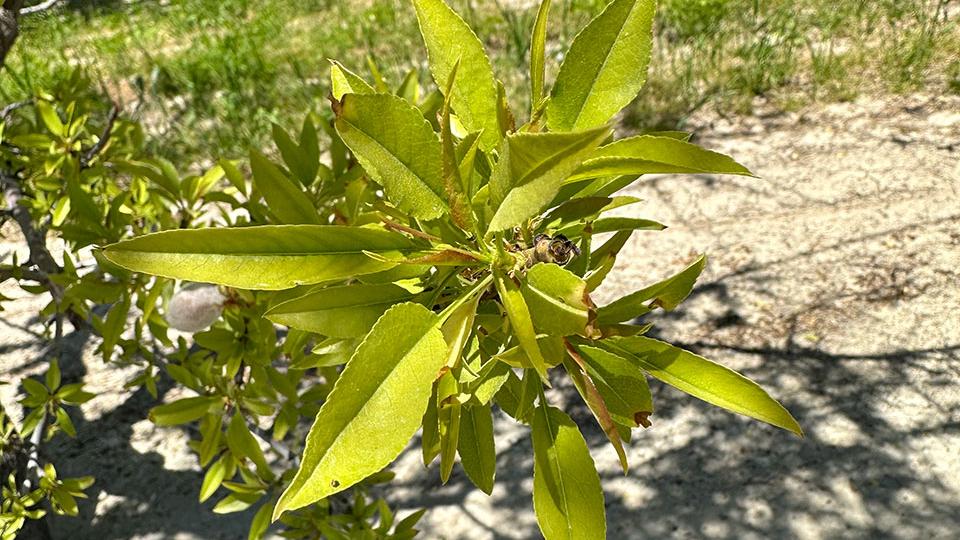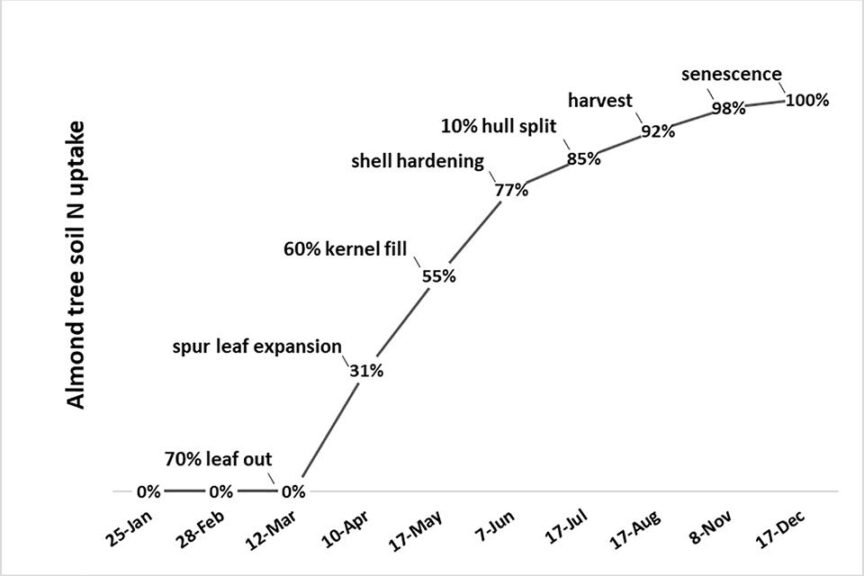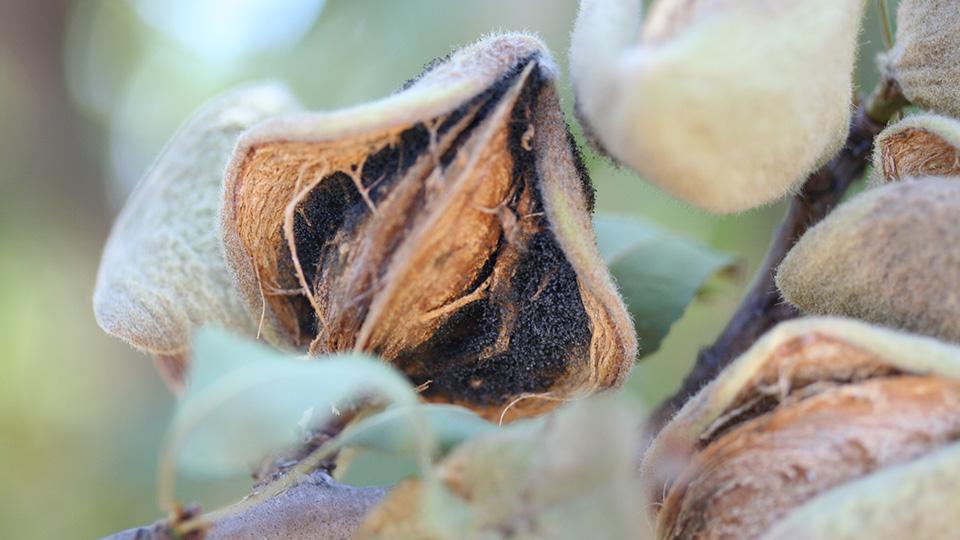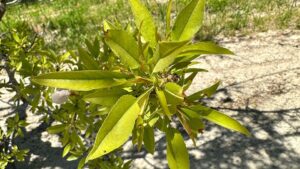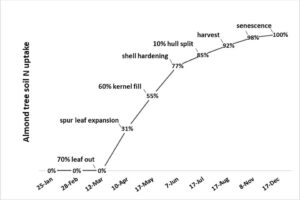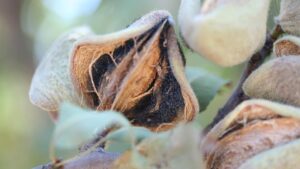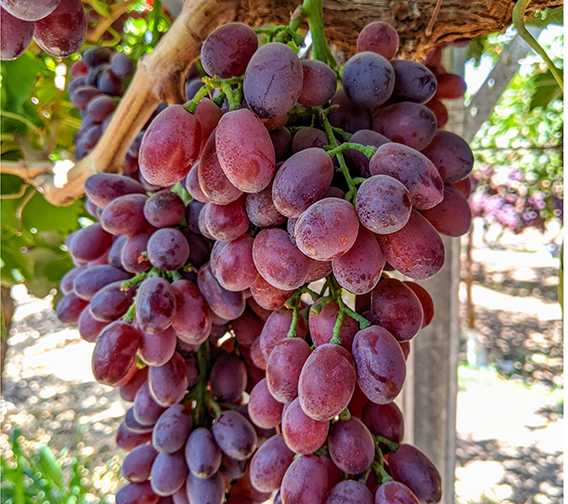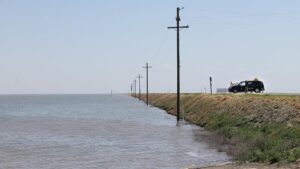Almond Nitrogen Management Considerations Following a Wet Winter
California agriculture has experienced a ‘weather whiplash’ year to remember. Staggering late-summer heat during harvest gave way to a cascade of unrelenting atmospheric rivers and record-breaking cold in some areas to start off 2023. In perennial almond orchard systems, drastic swings in weather patterns from one season to the next may have many unrecognized compounding effects on the growth and phenological development of the season’s crop. This year’s weather impacted the ability to conduct routine almond orchard practices like nitrogen (N) fertigation during spring as the newly set crop developed.
In ‘normal’ years, mature bearing almonds rapidly emerge from their winter’s rest into bloom, with nut set and leaf-out following soon after. Initial nitrogen requirements for flowering, fruit set, and early leaf emergence are satisfied by the remobilization of nutrient reserves from roots and perennial woody biomass. As demand increases to feed the expanding leaves and nuts as they enlarge and fill, internal storage reserves are soon depleted, which prompts trees to send out fresh feeder roots to utilize soil nutrients and satisfy the sharp increase in N consumption.
Almond N uptake research has shown the majority of N (>77%) is taken up between mid-leaf expansion and the end of kernel fill, with the remainder utilized from hull split to a few weeks after harvest to support the initiation and development of fruit buds for next season.
In typical years, the transition from perennial wood N remobilization to soil uptake begins around the second week of March. This year however, new leaves were just barely starting to green their canopies by this time. Below average soil temperatures and overly wet soil conditions undoubtably slowed the availability and demand for nutrient uptake. Fertilizer injections through the irrigation system or ground-shanked applications were delayed well into the first few weeks of April in many areas and signs of N and other nutrient deficiencies could be seen in some orchards in the Southern San Joaquin Valley. Without knowing how kernel-fill would progress, a ‘catch-up’ scenario ensued with the challenge to deliver N in a shorter window of time before the end of shell hardening around the first week of June.
SPREAD OUT APPLICATIONS
For some managers, delivering the season’s nitrogen requirement within a shorter timeframe resulted in larger application rates. This approach highlights a discrepancy between best management recommendations to apply N in multiple, low-rate applications, timed with demand throughout the season up until harvest, and what is commonly done, which is to finish up 80-90% of N applications by mid-May to early June. Applying the majority of the season’s nitrogen prior to early June increases unwanted vegetative growth and the likelihood of N losses to nitrate leaching below the rootzone.
Research-based N recommendations and actual on-farm practices sometimes diverge because managers are focused on managing against hull rot, a prevalent disease found in highly productive orchards. Hull rot infections have been correlated with elevated N fertilization rates (>250 lb./ac) in multiple trials. Hull rot is a fungal infection caused by three different pathogens including bread mold fungus (Rhizopus stolonifer), brown rot fungus (Monilinia fructicola), and in dry years, black mold (Aspergillus niger). The bread mold fungus is the most predominant causal agent of hull rot infections in the San Joaquin Valley, while brown rot is more commonly found in the Sacramento Valley. The disease gets established when fungal spores colonize freshly split hulls and release toxins that are systemically translocated to nearby shoots and spurs leading to dieback, which may make nuts difficult to remove at harvest.
Research into the physiological mechanisms of hull rot have found elevated N concentrations slow the progression of hull split initiation, with some speculation that a lag in the speed of hull opening enhances susceptibility for infection. Providing high N levels throughout annual crop development enhances hull growth, but possibly at the expense of the development of structural defenses to disease. Higher N coupled with excess irrigation increases the succulence and concentration of amino acids and other sugars in the developing hull, which are preferred sources of energy for Rhizopus sp. production of organic acids for growth. Almond hull sugar concentrations are even more enhanced when elevated N levels are coupled with high levels of irrigation water.
Increased irrigation rates have been correlated with higher orchard hull rot strikes, particularly when sets exceed >80% evapotranspiration (ETc) in the weeks just before harvest. Increased N and water also enhance vegetative growth, which can influence environmental factors within the orchard canopy. Changes in temperature, humidity, and light can increase the prevalence of disease. If orchard conditions support high levels of inoculum year after year, even trees with lower N fertilization will be susceptible to infection.
There are several recommended cultural and chemical practices that can help keep orchard fungal inoculum and hull rot strikes to a manageable level.
Revisit the N Budget
It pays to evaluate the progress of crop development and monitor problems with bloom, nut set, nut drop, and unexpected environmental factors to make adjustment decisions. In 2023, wet, cold conditions contributed to poor bee flight hours during bloom, and blossom-killing foliar diseases like bacterial blast (Pseudomonas syringae) was seen in some areas. A lighter crop for many areas throughout the state this year merited the reevaluation of nitrogen budgets. Unnecessarily overapplying N is expensive. Despite reported price drops in nitrogen fertilizer this spring compared to the last two years, the cost is still much higher than the previous 5-year average for commonly used materials like urea-ammonia-nitrate (UAN). Numerous trials have shown high-frequency and short-duration fertilizer applications increase N use efficiency, maintain N in rootzone, and reduce leaching. This is of particular importance when trying to catch up after early applications were missed due to heavy rain and wet soil. By kernel fill and shell hardening stage, roughly 80% of the season’s N should have been applied. If the orchard does not have a history of hull rot infestation, continue applying N to match the predicted demand with small frequent doses from the completion of kernel fill to a few weeks after harvest.
Irrigation Management
In addition to sensible N management, careful irrigation scheduling will ensure trees have adequate but not excessive water and reduce hull rot-favorable humidity within the canopy. Tree crops have been shown to benefit from mild to moderate levels of plant stress. A moderate, 10-25% irrigation deficit, applied at the onset of hull split for up to two weeks, can reduce hull rot up to 90% and increase the uniformity of hull split for an earlier harvest. Pressure chamber measurements increase precision and ensure trees are not overstressed. Maintain trees between -14 to -16 bars or roughly -4 bars below baseline during this time. Resume full irrigation after two weeks of deficit up until tapering irrigation to prepare for harvest.
Fungicide Timing
Apply fungicide at early hull split initiation stages to 10-20% split to decrease hull rot incidence. Both demethylation (sterol) inhibitor (DMI) FRAC group 3, and strobilurin, FRAC group 11 fungicides are highly effective controls for hull rot when integrated with deficit irrigation. A single application at hull split, timed with the navel orangeworm insecticide treatment, may reduce hull rot incidence by 60 to 70%. (https://ipm.ucanr.edu/agriculture/almond/hull-rot).
Careful N and irrigation management should be implemented to reduce the incidence of hull rot in almond orchards. There are free online resources available to schedule and track nitrogen and irrigation applications throughout the year. Contact your local UCCE farm advisor for more resources and information.





